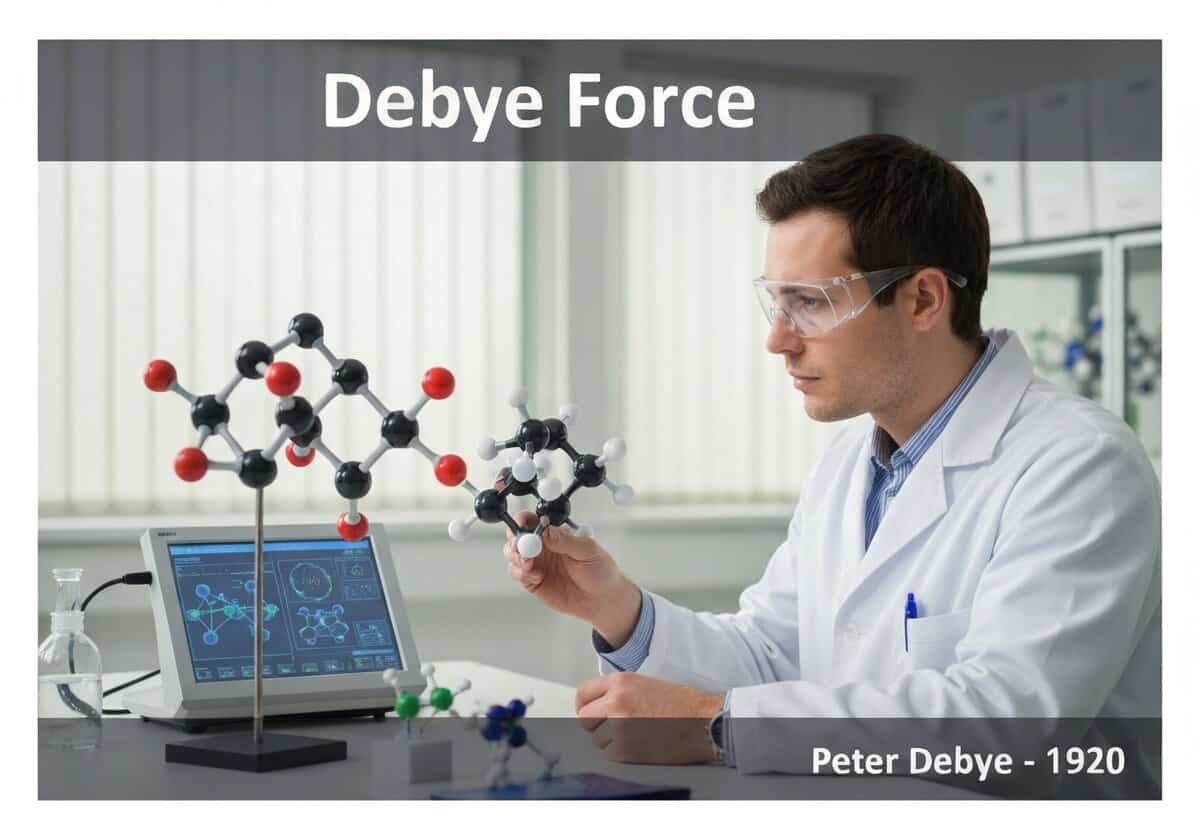An attractive intermolecular force between a polar molecule (with a permanent dipole) and a nonpolar molecule. The electric field from the permanent dipole distorts the electron cloud of the nonpolar molecule, inducing a temporary dipole in it. The two dipoles then attract each other. The interaction potential energy is [latex]V \propto -\frac{\alpha \mu^2}{r^6}[/latex], where [latex]\alpha[/latex] is polarizability and [latex]\mu[/latex] is the permanent dipole moment.
Debye Force (Dipole-Induced Dipole Interaction)
- Peter Debye

The Debye force, also known as the induction force, explains how a polar molecule can attract a nonpolar one. A polar molecule possesses a permanent electric dipole, which creates an electric field in its vicinity. When a nonpolar molecule enters this field, its electron cloud is distorted—electrons are pushed away from the negative end of the dipole and pulled toward the positive end. This separation of charge creates a temporary, ‘induced’ dipole in the nonpolar molecule. The interaction is always attractive because the induced dipole is always oriented favorably with respect to the permanent dipole that created it.
Unlike the Keesom force, the Debye force is not dependent on temperature. This is because the induced dipole is created by the permanent dipole and follows its orientation instantaneously, so thermal tumbling of the permanent dipole does not average out the attraction. The strength of the Debye force depends on two factors: the magnitude of the permanent dipole moment ([latex]\mu[/latex]) of the polar molecule and the polarizability ([latex]\alpha[/latex]) of the nonpolar molecule. While generally weaker than dipole-dipole forces, Debye forces are essential for understanding the behavior of mixtures containing both polar and nonpolar components.
النوع
الاضطراب
الاستخدام
السلائف
- Classical Electrodynamics and the concept of an electric field
- The theory of the permanent electric dipole moment
- The concept of atomic and molecular polarizability
التطبيقات
- explaining the solubility of nonpolar gases (like oxygen or nitrogen) in polar solvents (like water)
- modeling interactions in mixtures of polar and nonpolar substances
- understanding the formation of solvation shells around ions in solution
- adhesion between polar and nonpolar surfaces
براءات الاختراع:
أفكار ابتكارات محتملة
!!مستويات !!! العضوية مطلوبة
يجب أن تكون عضوًا !!! مستويات!!! للوصول إلى هذا المحتوى.
متاح للتحديات الجديدة
مهندس ميكانيكي، مشروع، هندسة العمليات أو مدير البحث والتطوير
متاح لتحدي جديد في غضون مهلة قصيرة.
تواصل معي على LinkedIn
تكامل الإلكترونيات المعدنية والبلاستيكية، التصميم مقابل التكلفة، ممارسات التصنيع الجيدة (GMP)، بيئة العمل، الأجهزة والمواد الاستهلاكية متوسطة إلى عالية الحجم، التصنيع المرن، الصناعات الخاضعة للتنظيم، شهادات CE وFDA، التصميم بمساعدة الحاسوب (CAD)، Solidworks، الحزام الأسود من Lean Sigma، شهادة ISO 13485 الطبية
احصل على جميع المقالات الجديدة
مجاني، لا يوجد بريد عشوائي، ولا يتم توزيع البريد الإلكتروني ولا إعادة بيعه
أو يمكنك الحصول على عضويتك الكاملة -مجانًا- للوصول إلى جميع المحتويات المحظورة >هنا<
الاختراع والابتكار والمبادئ التقنية ذات الصلة









